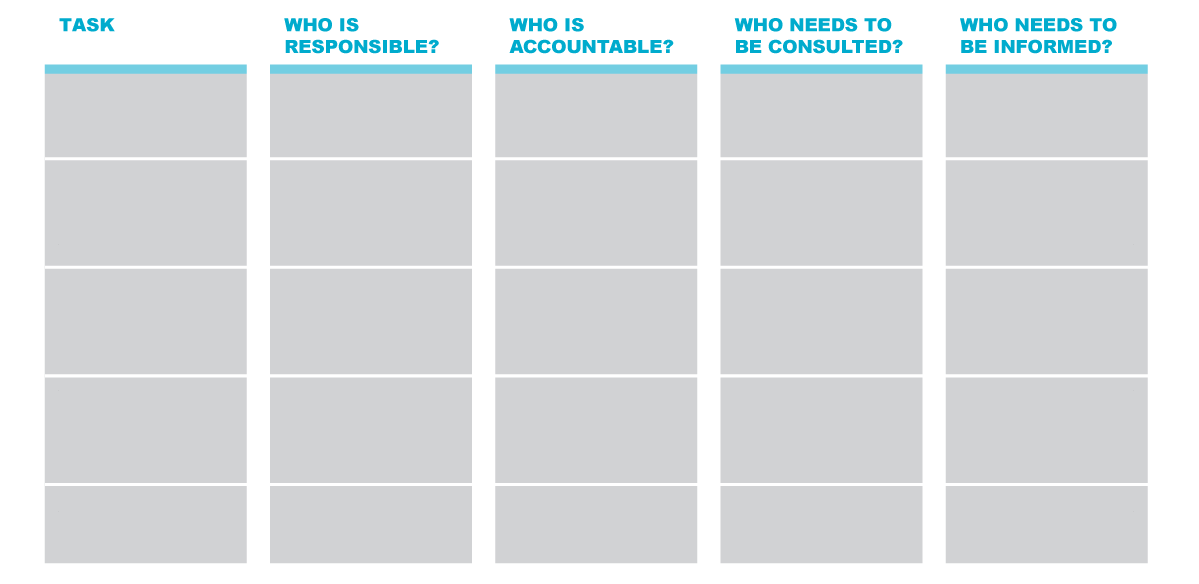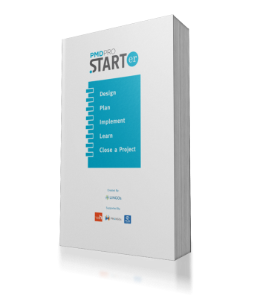RACI Diagram
I want to implement a project...
by clarifying the roles of stakeholders
LEVEL OF INVOLVEMENT: COMPLEX TOOL
This tool enables you to identify who needs to be involved in your project and how they will be involved.
This tool enables you to identify who needs to be involved in your project and how they will be involved.
Implement a project by clarifying the participation by various roles in completing tasks or deliverables for a project

WHAT is it?
Even the smallest projects depend on the input of many individuals. And as projects increase in complexity, so the web of relationships expands, potentially including community groups, government ministries, suppliers, local NGOs and other organizations.
A RACI diagram is a simple matrix that enables you to identify WHO needs to be involved at different stages and HOW they are involved. A left-hand column lists all of the activities that you need to complete as part of your project, and a a top row outlines the four areas of responsibility that are critical for project delivery. RACI is a four-letter acronym describing the different level of roles – responsible, accountable, consulted, and informed.
A RACI diagram is a simple matrix that enables you to identify WHO needs to be involved at different stages and HOW they are involved. A left-hand column lists all of the activities that you need to complete as part of your project, and a a top row outlines the four areas of responsibility that are critical for project delivery. RACI is a four-letter acronym describing the different level of roles – responsible, accountable, consulted, and informed.
HOW do I use it?
Teamwork: You already know from your Work Breakdown Structure and Network Diagram what activities need to be delivered to achieve your goals. Now, work with your team to list all of the tasks that need to be completed for each activity.
Next, ask your team to list all the stakeholders who need to be involved. For their latrine-building activity, UNITAS needs to deliver a variety of tasks from digging holes to building the shelter, and these tasks will involve a network of volunteers, engineers, local government, and community members.
The RACI diagram will help you to identify which individuals are critical for the delivery of your activity. Ask your team four key questions: Who is responsible for carrying out the task? Who is accountable for the correct completion of the task? Who needs to be consulted before moving forward with a task? And who needs to be informed during or at the end of the project?
Be precise. Make sure that you are nominating the right people for the right areas – involving too many could turn into a sign-off nightmare!
Leadership: You are accountable for the delivery of the project and can decide the level of responsibility that you want to give different members of staff, empowering them to step up and make decisions as appropriate. The bottom line is that everyone needs to be clear on what their role is, so that they can confidently get on with their job.
Your completed RACI diagram will provide the steering wheel that all stakeholders need to take ownership of their project functions. Do this well, and everyone will be clear and your project will run smoothly.
Next, ask your team to list all the stakeholders who need to be involved. For their latrine-building activity, UNITAS needs to deliver a variety of tasks from digging holes to building the shelter, and these tasks will involve a network of volunteers, engineers, local government, and community members.
The RACI diagram will help you to identify which individuals are critical for the delivery of your activity. Ask your team four key questions: Who is responsible for carrying out the task? Who is accountable for the correct completion of the task? Who needs to be consulted before moving forward with a task? And who needs to be informed during or at the end of the project?
Be precise. Make sure that you are nominating the right people for the right areas – involving too many could turn into a sign-off nightmare!
Leadership: You are accountable for the delivery of the project and can decide the level of responsibility that you want to give different members of staff, empowering them to step up and make decisions as appropriate. The bottom line is that everyone needs to be clear on what their role is, so that they can confidently get on with their job.
Your completed RACI diagram will provide the steering wheel that all stakeholders need to take ownership of their project functions. Do this well, and everyone will be clear and your project will run smoothly.
WHEN do I use it?
The best time to work on your RACI diagram is after you have completed the project design and planning phases. You have developed some excellent tools already, and are primed for implementation. As you move into this third phase, the RACI diagram will help you to pull in the people resources that you need at different levels for your project.
Who is involved?
You should complete the RACI diagram in consultation with your peers (to ensure that you have covered everyone), and then inform others so that they are clear.
Tips:
You consult to gain expertise, and have a duty to keep stakeholders informed of progress and project activities. It is important to record all those who have contributed on the RACI diagram – providing a complete picture of everyone involved in the project.
Additional Resources
Download the additional resources and the Project DPro (PMD Pro) Pocket Guide

Supported & Developed by:
Shared by:
Users are free to copy/redistribute and adapt/transform
for non-commercial purposes.
© 2022 All rights reserved.




